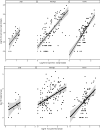Identification and characterization of immature Anopheles and culicines (Diptera: Culicidae) at three sites of varying malaria transmission intensities in Uganda
- PMID: 32576188
- PMCID: PMC7313098
- DOI: 10.1186/s12936-020-03304-7
Identification and characterization of immature Anopheles and culicines (Diptera: Culicidae) at three sites of varying malaria transmission intensities in Uganda
Abstract
Background: Over the last two decades, there has been remarkable progress in malaria control in sub-Saharan Africa, due mainly to the massive deployment of long-lasting insecticidal nets and indoor residual spraying. Despite these gains, it is clear that in many situations, additional interventions are needed to further reduce malaria transmission. The World Health Organization (WHO) has promoted the Integrated Vector Management (IVM) approach through its Global Vector Control Response 2017-2030. However, prior roll-out of larval source management (LSM) as part of IVM, knowledge on ecology of larval aquatic habitats is required.
Methods: Aquatic habitats colonized by immature Anopheles and culicines vectors were characterized at three sites of low, medium and high malaria transmission in Uganda from October 2011 to June 2015. Larval surveys were conducted along transects in each site and aquatic habitats described according to type and size. Immature Anopheles, culicines and pupae from the described habitats were sampled using standard dipping methods to determine larval and pupae densities. Larvae were identified as anopheline or culicine, and counted. Pupae were not identified further. Binary logistic regression analysis was used to identify factors associated with the presence of immature Anopheles and culicines in each site.
Results: A total of 1205 larval aquatic habitats were surveyed and yielded a total of 17,028 anopheline larvae, 26,958 culicine larvae and 1189 pupae. Peaks in larval abundance occurred in all sites in March-May and August-October coinciding with the rainy seasons. Anopheles larvae were found in 52.4% (n = 251) of aquatic habitats in Tororo, a site of high transmission, 41.9% (n = 536) of habitats in Kanungu, a site with moderate malaria transmission, and 15.8% (n = 418) in Jinja, a site with low malaria transmission. The odds of finding larvae was highest in rice fields compared to pools in both Tororo (odds ratio, OR = 4.21, 95% CI 1.22-14.56, p = 0.02) and Kanungu (OR = 2.14, 95% CI 1.12-4.07, p = 0.02), while in Jinja the odd were highest in containers (OR = 4.55, 95% CI = 1.09-19.14, p = 0.03). In Kanungu, larvae were less likely to be found in containers compared to pools (OR = 0.26, 95% CI 0.09-0.66, p = 0.008) and river fringe (OR = 0.19, 95% CI 0.07-0.52, p = 0.001). Medium sized habitats were associated with high odds of finding larvae compared to small habitats (OR = 3.59, 95% CI 1.18-14.19, p = 0.039).
Conclusions: These findings show that immature Anopheles and culicines were common in areas of high and moderate transmission but were rare in areas of low transmission. Although immature Anopheles and culicines were found in all types of water bodies, they were most common in rice fields and less common in open drains and in river fringes. Methods are needed to reduce the aquatic stages of anopheline mosquitoes in human-made habitats, particularly rice fields.
Keywords: Anopheles; Anopheline; Aquatic habitats; Culicine; Larvae; Malaria; Pupae; Uganda.
Conflict of interest statement
The authors declare that they have no competing interests.
Figures





Similar articles
-
Characterisation of anopheline larval habitats in southern Malawi.Acta Trop. 2020 Oct;210:105558. doi: 10.1016/j.actatropica.2020.105558. Epub 2020 May 30. Acta Trop. 2020. PMID: 32485166 Free PMC article.
-
Anopheles larval species composition and characterization of breeding habitats in two localities in the Ghibe River Basin, southwestern Ethiopia.Malar J. 2020 Feb 11;19(1):65. doi: 10.1186/s12936-020-3145-8. Malar J. 2020. PMID: 32046734 Free PMC article.
-
Aquatic habitats of the malaria vector Anopheles funestus in rural south-eastern Tanzania.Malar J. 2020 Jun 23;19(1):219. doi: 10.1186/s12936-020-03295-5. Malar J. 2020. PMID: 32576200 Free PMC article.
-
Contributions of Anopheles larval control to malaria suppression in tropical Africa: review of achievements and potential.Med Vet Entomol. 2007 Mar;21(1):2-21. doi: 10.1111/j.1365-2915.2007.00674.x. Med Vet Entomol. 2007. PMID: 17373942 Review.
-
Elevating larval source management as a key strategy for controlling malaria and other vector-borne diseases in Africa.Parasit Vectors. 2025 Feb 7;18(1):45. doi: 10.1186/s13071-024-06621-x. Parasit Vectors. 2025. PMID: 39915825 Free PMC article. Review.
Cited by
-
Malaria outbreak facilitated by engagement in activities near swamps following increased rainfall and limited preventive measures: Oyam District, Uganda.PLOS Glob Public Health. 2022 Aug 23;2(8):e0000239. doi: 10.1371/journal.pgph.0000239. eCollection 2022. PLOS Glob Public Health. 2022. PMID: 36962711 Free PMC article.
-
The application of drones for mosquito larval habitat identification in rural environments: a practical approach for malaria control?Malar J. 2021 May 31;20(1):244. doi: 10.1186/s12936-021-03759-2. Malar J. 2021. PMID: 34059053 Free PMC article.
-
Larval ecology and bionomics of Anopheles funestus in highland and lowland sites in western Kenya.PLoS One. 2021 Oct 11;16(10):e0255321. doi: 10.1371/journal.pone.0255321. eCollection 2021. PLoS One. 2021. PMID: 34634069 Free PMC article.
-
Altitude, not potential larval habitat availability, explains pronounced variation in Plasmodium falciparum infection prevalence in the western Kenya highlands.PLOS Glob Public Health. 2023 Apr 17;3(4):e0001505. doi: 10.1371/journal.pgph.0001505. eCollection 2023. PLOS Glob Public Health. 2023. PMID: 37068071 Free PMC article.
-
Predatory and competitive interaction in Anopheles gambiae sensu lato larval breeding habitats in selected villages of central Uganda.Parasit Vectors. 2021 Aug 21;14(1):420. doi: 10.1186/s13071-021-04926-9. Parasit Vectors. 2021. PMID: 34419140 Free PMC article.
References
-
- WHO. World malaria report 2019. Geneva, World Health Organization. Accessed https://www.who.int/publications-detail/world-malaria-report-2019 Accessed 16 Apr 2020.
-
- Mawejje HD, Wilding CS, Rippon EJ, Hughes A, Weetman D, Donnelly MJ. Insecticide resistance monitoring of field-collected Anopheles gambiae s.l. populations from Jinja, eastern Uganda, identifies high levels of pyrethroid resistance. Med Vet Entomol. 2013;27:276–283. doi: 10.1111/j.1365-2915.2012.01055.x. - DOI - PMC - PubMed
MeSH terms
Grants and funding
LinkOut - more resources
Full Text Sources
Medical

